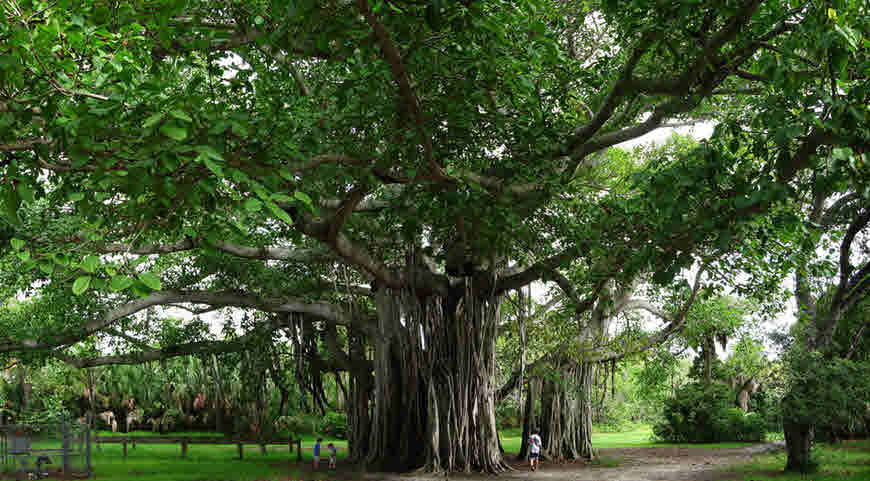Bargad or Vat-Vriksha is a sacred tree in Hinduism. In India, women offer prayer to this holy tree on occasion of Vat-Savitri. Vat symbolises all three gods of Hinduism. Lord Bramha is the roots, Lord Vishnu is the bark and Lord Shiva is the branches. It is believed goddess Lakshmi visits this tree on Sundays. All across country, everyone recognises and worships this holy tree.

This is large shade giving tree and in older times Banias or Hindu merchants used to do worship and business under the tree so British called it ‘the Banyan tree’.
Bargad is one of the four great Kshira-vriksha (Nalpamara) or milk-exuding tree, other three are peepal (F. religosa), plaksa (F. locor) and udumbara (F. glomerata).
Latin name: Ficus benghalensis
Taxonomy:
Kingdom: Plantae
Division: Magnoliophyta
Class: Magnolipsida
Order: Urticales
Family: Moraceae
Genus: Ficus
Species: F. benghalensis
Vernacular names of Banyan tree
| Hindi: Bargad, Bar, Nyagrodh Sanskrit: Bahupada, Vatah English: Banyan tree, Indian Banyan Assamese: Vat, Ahat, Vatgach Bengali: Bot Gujrati: Vad, Vadalo |
Tamil: Aalamaram Telugu: Peddamarri Kannada: Aala, Aladamara, Vata Malayalam: Ala, Vatam, Vatavriksham, Peraal Marathi: Vada |
Appearance
A huge evergreen tree with hanging aerial roots. Initially aerial roots are slender, when enters the ground these become thick like pillars.
Leaves are large and oval. Deep green on above and pale green underneath. On breaking, milky sap comes out of these leaves.
Flowers and fruits are inconspicuous.
Distribution
This large evergreen tree is distributed all over India from sub Himalayan region to deciduous forest of Deccan and south India.
Parts used for medicinal purpose
Stem bark, root bark, aerial roots, leaves, milky sap, fruits, and vegetative buds
Medicinal activities of the tree parts
The bark, leaves and fruits of Bargad tree have astringent, haemostatic, anti-septic, anti-inflammatory, antioxidant and anticancer activities. The latex is said to have an aphrodisiac action.
The bark of Bargad tree is astringent, cooling and alleviates vitiated condition of kapha and pitta.The infusion of bark cures dysentery, diarrhea, leucorrhoea, menorrhagia and nervous disorders.
The leaves of this holy tree is applied externally on skin diseases. The milky juice is externally applied for bruises and as a pain reliever in rheumatism and back pain.
The long aerial roots are also of medicinal importance. The tender aerial roots can chewed for teeth cleaning. These roots are anti-haemorrhagic (stops bleeding) and is useful in syphilis, biliousness, dysentery and inflammation of the liver.
For improving fertility and sperm count its tender twigs are grinded and taken with milk. The seeds are also reported to improve fertility.
Here are some post for specialized medicinal uses of Banyan Tree
Banyan is a tree with tremendous medicinal qualities, in Ayurvedic medicine system, it is used for the treatment of innumerable diseases. These remedies are simple, safe and can be done at home without any problem. But do keep in mind, herbal remedies works but takes time to show result.
Banyan tree use is recommended in Ayurveda for promoting fertility and curing sexual debility. Leaf- buds are prescribed in Ayurveda for promoting conception. According to Ayurveda, putting few drops of the banyan tree juice in the right nostril of the pregnant woman protects and gives good health to unborn baby.
For treating pre-mature ejaculation Banyan Tree latex and leaves are very effective and in India people are using this and women worshiping Banyan tree.
The anti-diabetic effect of Banyan Tree bark is due to the presence of flavonoids, water soluble and insoluble glycoside. In studies, the decoction and infusion was found effective in moderate diabetes but ineffective in severe diabetes.